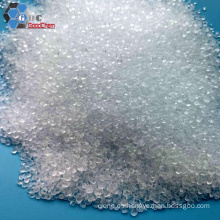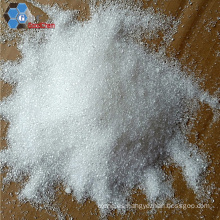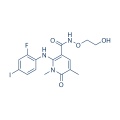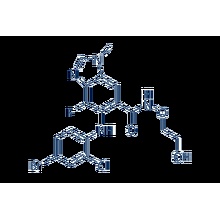.cp_wz tabla {borde superior: 1px sólido #ccc; borde izquierdo: 1px sólido #ccc; } .cp_wz table td {borde derecho: 1px sólido #ccc; borde inferior: 1px sólido #ccc; padding: 5px 0px 0px 5px;} .cp_wz table th {border-right: 1px solid #ccc; border-bottom: 1px solid #ccc; padding: 5px 0px 0px 5px;} \ n Peso molecular: \ n 461.23 AZD8330 es un inhibidor de MEK 1/2 competitivo no ATP, selectivo y novedoso con IC50 de 7 nM. Fase 1. \ n Actividad biológica AZD8330 inhibe potente y fuertemente MEK 1/2. AZD8330 no tiene actividad inhibidora contra más de 200 otras quinasas, incluidas concentraciones de hasta 10 μM. AZD8330 demuestra potencia sub-nanomolar en mecanicista (pERK) y potencia baja a sub-nanomolar en ensayos funcionales (proliferación) en líneas celulares sensibles al inhibidor de MEK 1/2. En un modelo farmacocinético / farmacodinámico (PK / PD) de xenoinjerto de rata Calu-6, una dosis oral única de 1,25 mg / kg de AZD8330 inhibe la fosforilación de ERK en> 90% durante entre 4 y 8 horas. Dosis tan bajas como 0,4 mg / kg una vez al día son suficientes para una inhibición del crecimiento tumoral> 80% en el modelo de xenoinjerto de rata desnuda Calu-6. En el modelo Calu-6, AZD8330 inhibe el crecimiento tumoral de una manera dependiente de la dosis, a 0,3 mg / kg y 1,0 mg / kg una vez al día. Protocolo (solo como referencia) Ensayo de quinasa: [2]
|
MEK1 enzymatic assays
|
NH2-terminal hexahistidine tagged, constitutively active MEK1 (S218D, S222D ΔR4F) is expressed in baculovirus-infected Hi5 insect cells and purified by immobilized metal affinity chromatography, ion exchange, and gel filtration. The activity of MEK1 is assessed by measuring the incorporation of [γ- 33P]phosphate from [γ-33P]ATP onto ERK2. The assay is carried out in a 96-well polypropylene plate with an incubation mixture (100 μL) composed of 25 mM HEPES (pH 7.4), 10 mM MgCl2, 5 mM β-glycerolphosphate, 100 μM sodium orthovanadate, 5 mM DTT, 5 nM MEK1, 1 μM ERK2, and 0 to 80 nM AZD8330 (final concentration of 1% DMSO). The reactions are initiated by the addition of 10 μM ATP (with 0.5 μC k[γ-33P]ATP/well) and incubated at room temperature for 45 min. An equal volume of 25% trichloracetic acid is added to stop the reaction and precipitate the proteins. Precipitated proteins are trapped onto glass fiber B filter plates, excess labeled ATP is washed off with 0.5% phosphoric acid, and radioactivity is counted in a liquid scintillation counter. ATP dependence is determined by varying the amount of ATP in the reaction mixture. The data are globally fitted.
|
Ensayo celular: [1]
|
Cell lines
|
Malme-3M melanoma cells
|
|
Concentrations
|
~10 μM
|
|
Incubation Time
|
1 hour
|
|
Method
|
Malme-3M melanoma cells are plated in 96-wells and treated with various concentrations of AZD8330 for 1 hour at 37 °C. The cells are fixed, permeabilized, and incubated with an anti-phospho-ERK antibody and an anti-ERK 1/2 antibody. Plates are washed and fluorescently-labeled secondary antibodies are added. Plates are analyzed on a LICOR fluorescence imager. The pERK signal is normalized to the total ERK signa
|
Estudio con animales: [1]
|
Animal Models
|
Female nude rats (NIH rnu/rnu) with Calu-6 cells, nude rats with SW620 cells
|
|
Formulation
|
0.5% HPMC-0.1% Tween
|
|
Dosages
|
0.3 mg/kg, 1 mg/kg
|
|
Administration
|
Oral administration
|
|
Solubility
|
0.5% hydroxyethyl cellulose/0.1% Tween 80,
30 mg/mL
|
|
* Please note that Selleck tests the solubility of all compounds in-house, and the actual solubility may differ slightly from published values. This is normal and is due to slight batch-to-batch variations.
|
Conversión de diferentes modelos de animales basados en BSA (valor basado en datos del Borrador de Directrices de la FDA)
|
Species
|
Baboon
|
Dog
|
Monkey
|
Rabbit
|
Guinea pig
|
Rat
|
Hamster
|
Mouse
|
|
Weight (kg)
|
12
|
10
|
3
|
1.8
|
0.4
|
0.15
|
0.08
|
0.02
|
|
Body Surface Area (m2)
|
0.6
|
0.5
|
0.24
|
0.15
|
0.05
|
0.025
|
0.02
|
0.007
|
|
Km factor
|
20
|
20
|
12
|
12
|
8
|
6
|
5
|
3
|
|
Animal A (mg/kg) = Animal B (mg/kg) multiplied by
|
Animal B Km
|
|
Animal A Km
|
Por ejemplo, para modificar la dosis de resveratrol utilizada para un ratón (22,4 mg / kg) a una dosis basada en el BSA para una rata, multiplique 22,4 mg / kg por el factor Km para un ratón y luego divida por el factor Km para una rata. Este cálculo da como resultado una dosis equivalente para ratas de resveratrol de 11,2 mg / kg.
|
Rat dose (mg/kg) = mouse dose (22.4 mg/kg) ×
|
mouse Km(3)
|
= 11.2 mg/kg
|
|
rat Km(6)
|
Información química
|
Molecular Weight (MW)
|
461.23
|
|
Formula
|
C16H17FIN3O4
|
|
CAS No.
|
869357-68-6
|
|
Storage
|
3 years -20℃Powder
|
|
6 months-80℃in solvent (DMSO, water, etc.)
|
|
Synonyms
|
ARRY704
|
|
Solubility (25°C) *
|
In vitro
|
DMSO
|
92 mg/mL
(199.46 mM)
|
|
Water
|
<1 mg/mL
(
|
|
Ethanol
|
92 mg/mL
(199.46 mM)
|
|
In vivo
|
0.5% hydroxyethyl cellulose/0.1% Tween 80
|
30 mg/mL
|
* <1 mg/ml means slightly soluble or insoluble.
* Please note that Selleck tests the solubility of all compounds in-house, and the actual solubility may differ slightly from published values. This is normal and is due to slight batch-to-batch variations.
|
|
Chemical Name
|
2-(2-fluoro-4-iodophenylamino)-N-(2-hydroxyethoxy)-1,5-dimethyl-6-oxo-1,6-dihydropyridine-3-carboxamide
|
Calculadora de molaridad Calculadora de dilución Calculadora de peso molecular
Grupos de Producto : MAPK > Inhibidor de MEK











